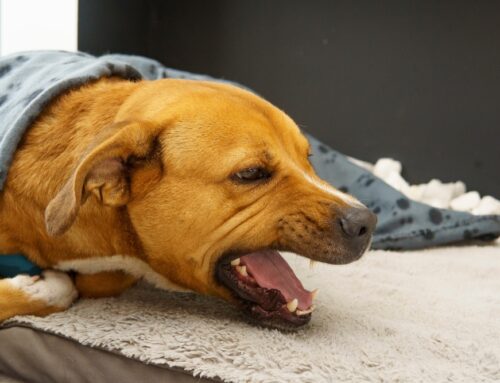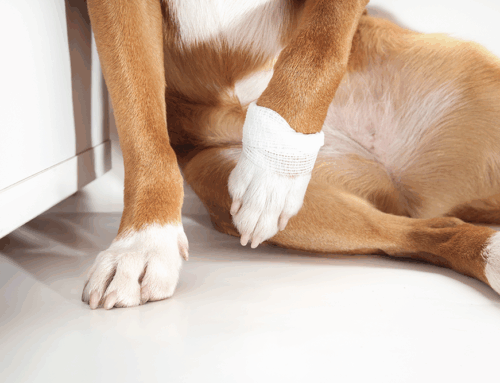Hair Loss in Pets: Common Causes and When to Worry
Noticing bald spots or thinning patches in your pet’s coat can raise a lot of questions. Is it just normal shedding, or a sign that something’s wrong? At Bayview Animal Hospital in St. Petersburg, Florida, we know hair loss in pets isn’t always straightforward. That’s why we take the time to investigate the cause, explain what it means, and create a care plan that helps your pet feel better- inside and out.
What Is Hair Loss (Alopecia) in Pets?
Hair loss, also known as alopecia, refers to partial or complete loss of fur. It can be sudden or gradual, occur in patches or be widespread. While it may sometimes resemble normal shedding, alopecia is usually a sign that something else is going on beneath the surface. Shedding is part of a healthy hair cycle. Alopecia often signals an underlying medical issue that needs attention.
What Causes Hair Loss in Dogs and Cats?
Hair loss isn’t just cosmetic. It’s often your pet’s way of signaling something deeper is wrong. Left untreated, underlying conditions can worsen, leading to chronic infections, systemic illness, or even conditions that can spread to other pets- or people. Quick diagnosis leads to quicker relief and a healthier coat. Hair loss can happen for a variety of reasons. Some of the most common include:
- Parasites: Fleas, mites, and lice irritate the skin and lead to scratching, biting, and bald spots. Flea allergy dermatitis is one of the most common culprits in both cats and dogs.
- Allergies: Reactions to food, pollen, dust, or flea saliva can cause inflammation and hair loss.
- Infections: Bacterial infections and fungal issues like ringworm often lead to patchy bald spots. These are usually treatable with topical or oral medication.
- Endocrine Disorders: Conditions like hypothyroidism and Cushing’s disease disrupt hormone balance and often lead to symmetrical hair loss.
- Genetic Conditions: Some breeds are prone to inherited disorders, including color dilution alopecia and canine flank alopecia.
- Stress and Overgrooming: Particularly in cats, stress can lead to excessive licking, chewing, or biting, resulting in bald spots.
- Nutritional Deficiencies: A poor-quality or unbalanced diet can affect coat health.
- Hormone Cream Exposure: Pets who come into contact with transdermal hormone creams (from human use) may experience localized or generalized hair loss due to hormonal absorption.
- Medication Reactions: Certain medications or vaccines may cause hair loss as a side effect.
For more on symptoms and treatments, see Hair Loss (Alopecia) in Dogs – PDSA
How to Recognize the Early Signs of Hair Loss
Hair loss in pets doesn’t always show up the same way. Sometimes it’s a clear bald patch that suddenly appears. Other times, it’s more subtle- like a thinning coat, extra scratching, or irritated skin that looks red, flaky, or thickened. You might notice your pet licking or chewing a particular spot over and over, or catch a glimpse of flea dirt during a grooming session.
These early clues often point to an underlying issue, and catching them quickly gives your pet the best chance at a full and comfortable recovery.
Why Timely Treatment Matters
When hair loss is ignored, it rarely resolves on its own. What starts as a mild skin irritation can spiral into more serious complications, like deep infections, open wounds, or scarring that damages the hair follicles permanently.
In some cases, especially with contagious conditions like mange or ringworm, the problem can spread to other pets- or even to people. And if the hair loss is related to a larger medical issue, such as a hormonal imbalance, waiting too long to treat it may allow the disease to progress unchecked.
Beyond the physical toll, ongoing skin discomfort can take a real emotional toll on pets. You may see changes in behavior- less playfulness, more irritability, or a reluctance to be touched.
The sooner we pinpoint the cause, the sooner your pet can start feeling better.
How We Diagnose Alopecia
At Bayview Animal Hospital, we take a comprehensive approach to diagnosing skin and coat issues. A typical work-up includes:
- Physical exam and dermatologic assessment
- Skin cytology: We use tape or slides to look for bacteria, fungus, mites, or yeast under the microscope
- Fungal cultures for ringworm or dermatophytes
- Skin scrapes to identify mites like Demodex or Sarcoptes
- Bloodwork to check for thyroid dysfunction, Cushing’s disease, or other systemic causes. Learn More: Why blood work matters
- Culture and sensitivity testing for resistant infections
- Food trials or parasite treatment trials when allergies are suspected
Getting a clear diagnosis helps us create a treatment plan tailored to your pet’s needs. If you’re concerned, Book Appointment to get started.
Treatment Options
| Cause | Recommended Treatment |
| Fleas or Mites | Year-round preventatives, anti-parasitic medications |
| Allergies | Parasite control, dietary trials, antihistamines, immunotherapy |
| Infections | Oral/topical antibiotics or antifungals |
| Hormonal Disorders | Medication to correct imbalances |
| Nutrition Deficiencies | Dietary improvements or supplementation |
| Stress / Overgrooming | Enrichment, behavior therapy, anxiety medications |
| Hormone Cream Exposure | Avoidance and monitoring hormone levels |
Your pet’s treatment may include medicated shampoos, regular grooming, and follow-up diagnostics. Learn more from the ASPCA’s guide to grooming and coat care. Have questions? Contact our team for guidance tailored to your pet’s needs.
Preventing Future Hair Loss
While not every case is preventable, these steps can help protect your pet’s skin and coat:
- Stick to monthly flea, tick, and mite prevention: Learn more about the importance of year-round parasite prevention.
- Feed a balanced, vet-recommended diet
- Schedule regular grooming and bathing
- Minimize stress and support mental stimulation
- Keep hormone creams or topical medications away from pets. If you use a hormonal cream, don’t let them lick or come into contact with that part of your skin.
- See your vet at the first sign of skin changes, and keep up with yearly wellness visits and blood panels to catch any problems early- before the hair loss starts.
FAQs About Hair Loss in Pets
Is pet hair loss contagious?
Some conditions, like ringworm and mange, are contagious to people and other pets. Others, like allergies or hormonal issues, are not.
Will my pet’s hair grow back?
Often, yes. Once the underlying cause is treated, regrowth typically begins in a few weeks to months. If the hair loss is due to scarring, has been very chronic, or has been caused by a genetic issue or hormonal imbalance, it may not come back- or only partially. The sooner you address it, the better your chances are.
Can I treat it at home?
You can soothe minor irritation, but effective diagnosis and treatment require veterinary care. Home remedies may delay proper care or worsen the issue.
Your Partner in Pet Health
Hair loss can be a sign of something small- or something more complex. Either way, you don’t have to navigate it alone. At Bayview Animal Hospital, we’re committed to helping you understand what’s going on and how to restore your pet’s comfort and confidence.
Book Appointment or get in touch today. We’ll help get your pet back to feeling good- and looking great.








Leave A Comment